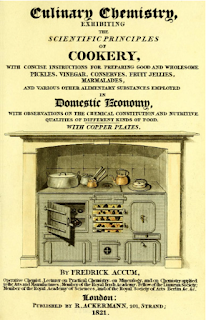The following pages are intended to exhibit a popular view of the philosophy of cookery, to enable the reader to understand the chemical principles, by means of which alimentary substances are rendered palatable and nutritious. The subject may appear frivolous; but let it be remembered that it is by the application of the principles of philosophy to the ordinary affairs of life, that science diffuses her benefits, and perfects her claim to the gratitude of mankind.
The art of preparing good and wholesome food is, undoubtedly, a branch of chemistry; the kitchen is a chemical laboratory; all the processes employed for rendering alimentary substances fit for human sustenance, are chemical processes; and much waste of the materials, as well as labour to the parties, might often be spared, were those who practise this art, made acquainted with some simple chemical truths which invariably would lead to certain results.
från förordet i Culinary Chemistry
I dag hittar jag en bok med den oemotståndliga titeln Culinary Chemistry, The Scientific Principles of Cookery, with Concise Instructions for Preparing Good and Wholesome Pickles, Vinegar, Conserves, Fruit Jellies, Marmalades, and Various Other Alimentary Substances Employed in Domestic Economy, with Observations on the Chemical Constitution and Nutritive Qualities of Different Kinds of Food. En bok från 1821 skriven av kemisten Frederick Accum, en man som förefaller vara lika intressant som boken. Han har förresten skrivit rätt många böcker, de flesta har med gas som värmekälla och upplysning att göra. Men han engagerade sig också i det utbredda matfusket, och skrev böcker om hur man skulle kunna veta att det inte fanns otillåtna tillsatser i maten man köpte, något som skaffade honom många fiender. Du hittar dem både hos Gutenberg och internet archive.
De första 80 sidorna ägnas åt råvaror och matvanor, sedan följer olika tillagningssätt och i sista delen av boken finns recept. Så här års passar det ju bra, med tips om hur man konserverar, lägger in, syltar och saftar — men jag får väl erkänna att jag förmodligen inte kommer att prova några av recepten, hur intressanta jag än tycker att de är.
Cherry Pie
PIES
Are those dishes which consist either of meat, or of fruit, covered with a farinaceous crust, enriched with butter or other fat, and rendered fit for eating by baking.
The crust of the pie is usually made of two parts by weight of wheaten flour, and one part of butter, lard, or other fat.
The flour is made into a stiff paste with cold water, and rolled out on a board with a paste pin to the thickness of about one quarter of an inch, the board being previously sprinkled over with flour to prevent the dough from sticking to the board. About one-sixth part of the butter, in pieces of the size of a nutmeg, is put over the extended paste, and the whole again dusted with flour; the paste is then doubled up and rolled out as before. A like portion of butter is again distributed over the paste, which, after being doubled up, is rolled out, and the same operation is repeated till the whole quantity of butter is thus incorporated with the flour.
Part of the paste is then laid, one quarter or half an inch in thickness, over the inside of a deep dish in which the pie is to be baked, and the meat, cut in chops or slices, is put into the dish, together with the seasonings, and a portion of water or gravy, about one tea cup full, to one pound of meat. The contents of the basin are then covered with a lid, made of the remainder of the paste, rolled out rather thicker than the inside lining of the dish, and the lid is made to adhere to the inside sheeting, which should extend over the rim of the dish, by pressing the top paste close upon the margin. A few small holes are then made in the top crust, and the pie is put in the oven.
The baking should be slow. If the pie be put into a hot oven, the crust becomes hard, and many a cook is blamed for making bad pies, when the fault really lies with the baker. A light and flaky pie crust can only be produced by the judicious application in the manner stated, of the butter, or fatty matter. By this means the butter is distributed, in distinct layers, through the mass of the pie crust. The flour dusted over each layer prevents the paste forming one mass, or, as it is called, becoming heavy. The more frequently, therefore, the paste is rolled out with butter, lard, or other fat, interposed between each layer, provided the layers are dusted over with flour, the more flaky will be the pie; and hence, also, by increasing the quantity of butter, to a certain limit, the flakeness of the pie crust becomes increased.
Pastry cooks usually allow from ten to twelve ounces of butter to one pound of flour for making a light puff paste, such as they use for tarts and patties.
Till en god paj krävs riktigt gott te, och boken avslutas med ett par stycken on om både kaffe och te — men först avhandlas teets historia, och sedan diskuterar han olika tekannors nack- och fördelar — jag brygger nog mitt te, som jag alltid gjort.
Lady Dorothy
målning av Henry Graves
En bild jag hämtat från ett annat av dagens fynd, Leaves from the Note-Books of Lady Dorothy Nevill, by Lady Dorothy Nevill. Jag har inte hunnit bekanta mig med Lady Dorothy än, men hon verkar vara en intressant person.



































